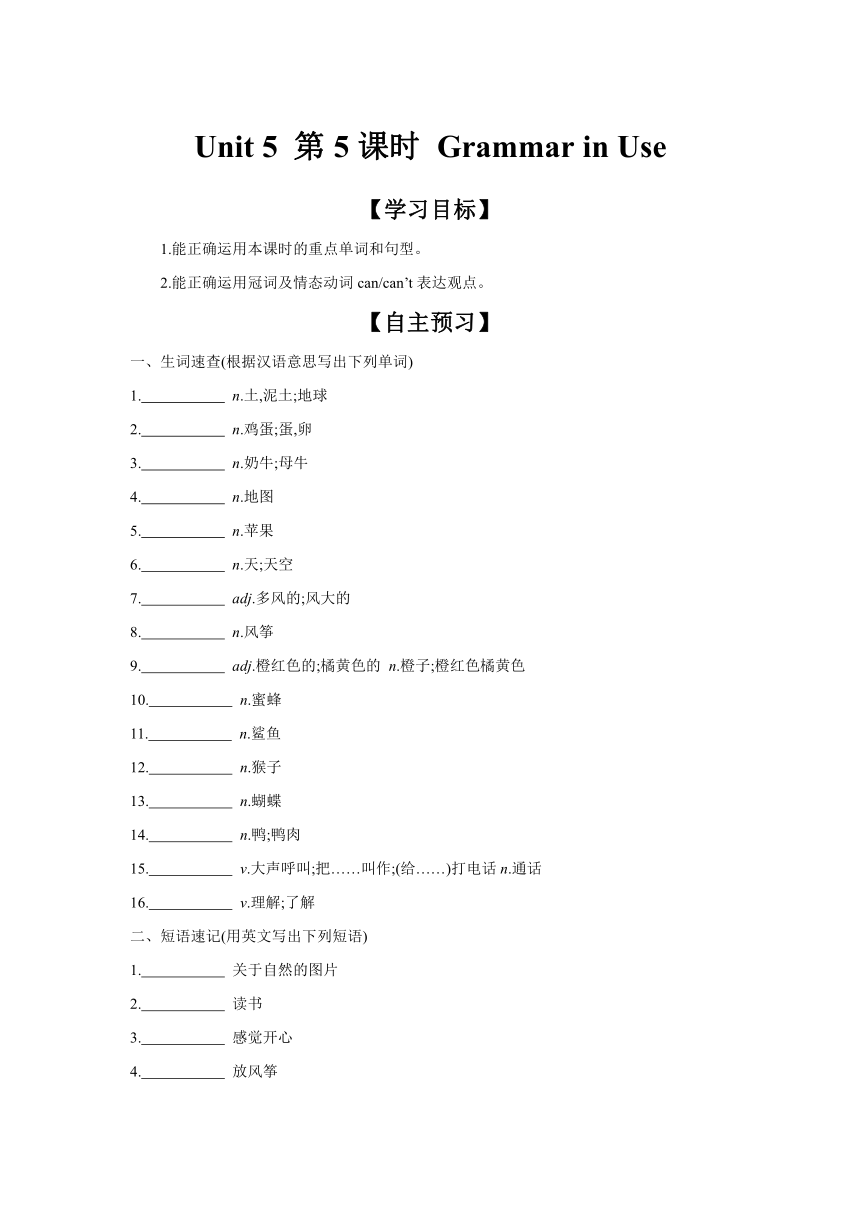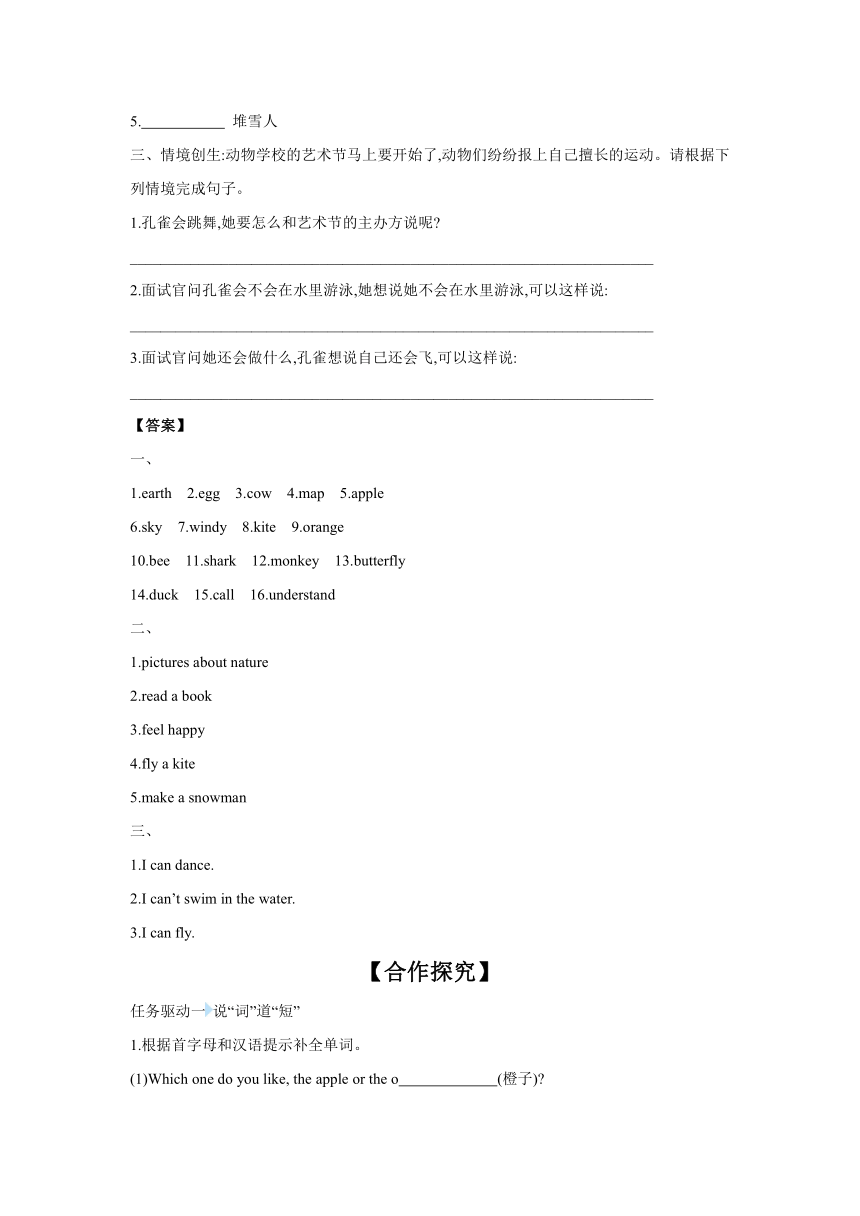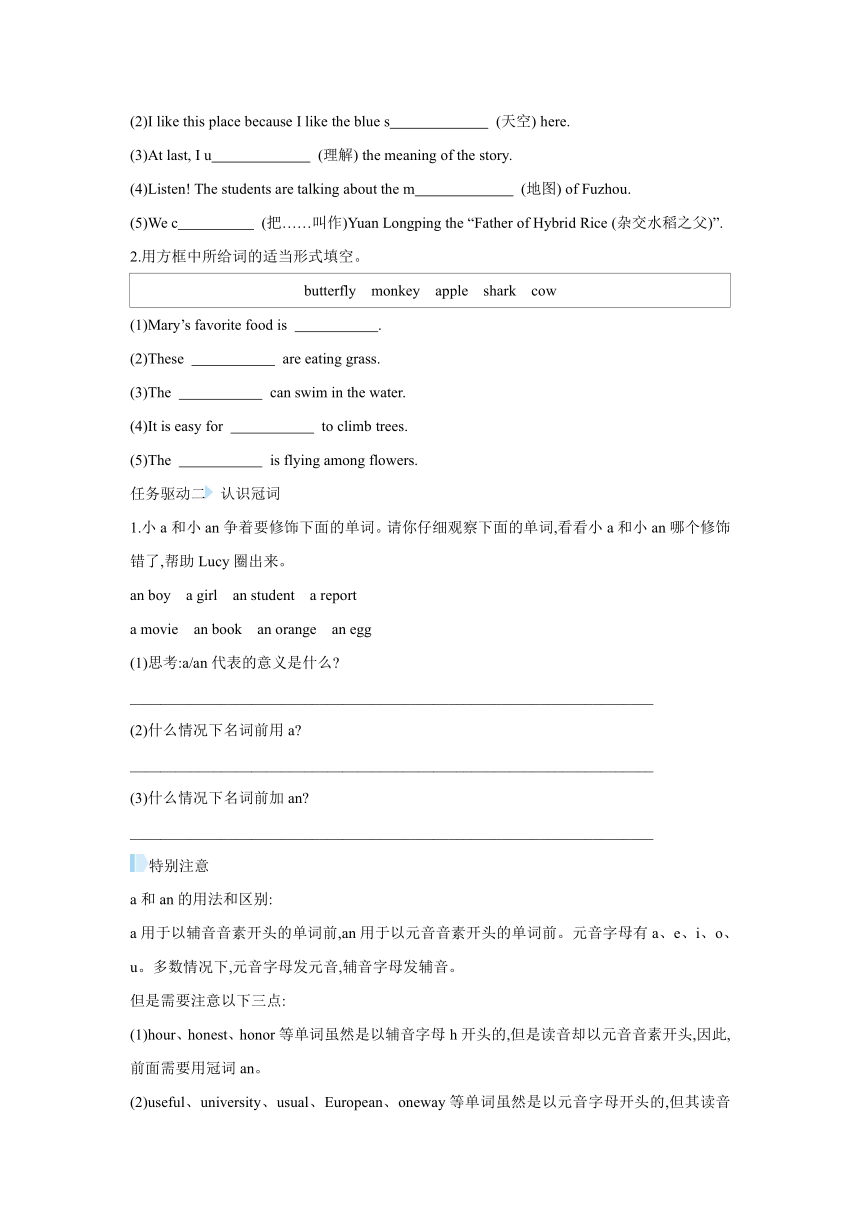【学习任务单】Unit 5 Love Mother Nature! 第5课时 Grammar in Use (含答案) 2024-2025学年英语仁爱科普版七年级上册
文档属性
| 名称 | 【学习任务单】Unit 5 Love Mother Nature! 第5课时 Grammar in Use (含答案) 2024-2025学年英语仁爱科普版七年级上册 |  | |
| 格式 | docx | ||
| 文件大小 | 45.2KB | ||
| 资源类型 | 教案 | ||
| 版本资源 | 仁爱科普版 | ||
| 科目 | 英语 | ||
| 更新时间 | 2024-12-26 19:05:02 | ||
图片预览



文档简介
Unit 5 第5课时 Grammar in Use
【学习目标】
1.能正确运用本课时的重点单词和句型。
2.能正确运用冠词及情态动词can/can’t表达观点。
【自主预习】
一、生词速查(根据汉语意思写出下列单词)
1. n.土,泥土;地球
2. n.鸡蛋;蛋,卵
3. n.奶牛;母牛
4. n.地图
5. n.苹果
6. n.天;天空
7. adj.多风的;风大的
8. n.风筝
9. adj.橙红色的;橘黄色的 n.橙子;橙红色橘黄色
10. n.蜜蜂
11. n.鲨鱼
12. n.猴子
13. n.蝴蝶
14. n.鸭;鸭肉
15. v.大声呼叫;把……叫作;(给……)打电话n.通话
16. v.理解;了解
二、短语速记(用英文写出下列短语)
1. 关于自然的图片
2. 读书
3. 感觉开心
4. 放风筝
5. 堆雪人
三、情境创生:动物学校的艺术节马上要开始了,动物们纷纷报上自己擅长的运动。请根据下列情境完成句子。
1.孔雀会跳舞,她要怎么和艺术节的主办方说呢
_____________________________________________________________________
2.面试官问孔雀会不会在水里游泳,她想说她不会在水里游泳,可以这样说:
_____________________________________________________________________
3.面试官问她还会做什么,孔雀想说自己还会飞,可以这样说:
_____________________________________________________________________
【答案】
一、
1.earth 2.egg 3.cow 4.map 5.apple
6.sky 7.windy 8.kite 9.orange
10.bee 11.shark 12.monkey 13.butterfly
14.duck 15.call 16.understand
二、
1.pictures about nature
2.read a book
3.feel happy
4.fly a kite
5.make a snowman
三、
1.I can dance.
2.I can’t swim in the water.
3.I can fly.
【合作探究】
任务驱动一说“词”道“短”
1.根据首字母和汉语提示补全单词。
(1)Which one do you like, the apple or the o (橙子)
(2)I like this place because I like the blue s (天空) here.
(3)At last, I u (理解) the meaning of the story.
(4)Listen! The students are talking about the m (地图) of Fuzhou.
(5)We c (把……叫作)Yuan Longping the “Father of Hybrid Rice (杂交水稻之父)”.
2.用方框中所给词的适当形式填空。
butterfly monkey apple shark cow
(1)Mary’s favorite food is .
(2)These are eating grass.
(3)The can swim in the water.
(4)It is easy for to climb trees.
(5)The is flying among flowers.
任务驱动二 认识冠词
1.小a和小an争着要修饰下面的单词。请你仔细观察下面的单词,看看小a和小an哪个修饰错了,帮助Lucy圈出来。
an boy a girl an student a report
a movie an book an orange an egg
(1)思考:a/an代表的意义是什么
_____________________________________________________________________
(2)什么情况下名词前用a
_____________________________________________________________________
(3)什么情况下名词前加an
_____________________________________________________________________
特别注意
a和an的用法和区别:
a用于以辅音音素开头的单词前,an用于以元音音素开头的单词前。元音字母有a、e、i、o、u。多数情况下,元音字母发元音,辅音字母发辅音。
但是需要注意以下三点:
(1)hour、honest、honor等单词虽然是以辅音字母h开头的,但是读音却以元音音素开头,因此,前面需要用冠词an。
(2)useful、university、usual、European、oneway等单词虽然是以元音字母开头的,但其读音却以辅音音素开头,因此,这些单词前面要用冠词a。
(3)在26个英文字母当中,a、e、i、o、f、h、l、m、n、r、s、x,这12个字母的读音都是以元音音素开头的。
2.探究定冠词the的用法。
(1)定冠词the在英语中具有多种用法,主要用于特指某个或某些人、物或概念。
(2)观察下列句子,在横线上写出定冠词都用于什么情况。
①The teacher is very kind.
_____________________________________________________________________
②I saw a dog. The dog was very cute.
_____________________________________________________________________
③The sun is big.
_____________________________________________________________________
④He is the first one to get here.
_____________________________________________________________________
⑤I want to visit the Great Wall.
_____________________________________________________________________
⑥I like playing the piano.
_____________________________________________________________________ 定冠词the用法歌诀 特指双熟悉,上文已提及; 世上独无二,序数最高级; 某些专有名,习语及乐器。
3.用适当的冠词填空。
There is (1) big zoo in my hometown. I often go there with my parents on (2) weekend. It’s not too far from my home to (3) zoo.
There are four pandas in the zoo. (4) little pandas are so cute. They are one of China’s symbols. Now, my parents and I are watching (5) pandas. They are very friendly.
任务驱动三 情态动词学习
1.阅读下面的句子,在描述正确的句子前打√,在描述有误的句子前打×。
( )(1)Elephants can fly in the sky.
( )(2)Fish can swim in the water.
( )(3)Monkeys can climb trees.
( )(4)Fish can’t swim in the water.
( )(5)Cows can’t climb trees.
2.用can 和 can’t填空。
(1)Monkeys fly in the sky.
(2)Students play soccer on the playground.
(3)Little children swim in the river.
(4)Bees fly among flowers.
(5)Sharks walk on the road.
3.探究情态动词can的用法。
情态动词表示说话人的语气和情态,不能独立作谓语,只能和实义动词一起构成谓语。 常见的情态动词有can、may、could、must、have to、should、would等,其后动词使用 形。情态动词一般没有 和数的变化,它的否定式一般是在其后加 构成,在一般疑问句中通常将情态动词提到 。
【答案】
任务驱动一
1.(1)orange (2)sky (3)understand
(4)map (5)call
2.(1)apples (2)cows (3)shark
(4)monkeys (5)butterfly
任务驱动二
1.an boy an student an book
(1)a/an通常表示数量“一”,后接可数名词单数,泛指任意一个人或一件事,也可以表示一类人或事物。
(2)辅音音素开头的可数名词单数前加a。
(3)元音音素开头的可数名词单数前加an。
2.(2)①指特定的人或事物,以及双方都熟悉的人或事物。
②上文中已经提到过的人或事物,再次提到时要用定冠词the。
③指世界上独一无二的事物。
④用在序数词前面。
⑤用在某些专有名词前。
⑥用在表示乐器的名词前。
3.(1)a (2)the (3)the (4)The (5)the
任务驱动三
1.(1)× (2)√ (3)√ (4)× (5)√
2.(1)can’t (2)can (3)can’t (4)can
(5)can’t
3.原 人称 not 句首
【知识超市】
I am reading a book. 我正在看书。
It is great fun to watch him in the zoo.在动物园里看他真是太有趣了。
用法总结 read意为“阅读”;watch意为“注视”。
知识拓展 辨析read、watch、see与look
单词含义及用法图示
read意为“阅读”,其后常接图书和报纸等 read a book 看书
watch意为“注视;观看”,其后常接电视节目、比赛等 watch TV 看电视
look意为“看”,强调动作,其后加宾语时要用“look at” look at me 看着我
see意为“看见”,强调结果,也可翻译成“明白” I see a butterfly. 我看见了一只蝴蝶。
记忆口诀:watch 专注用时长,比赛影视常登场。
see 以结果为导向,看到内容心中藏。
look 动作要先想,单独使用不恰当。
look at 搭配强,指向目标不能忘。
read 文字书中躺,阅读书籍心欢畅。
素养训练 选词填空。
watch see read look
1.I would like to TV at home instead of (而不是) playing soccer outside.
2.Nancy and Cindy want to go the library to books.
3. at the picture on the wall!
4.I can’t the words on the blackboard.
【答案】
1.watch 2.read 3.Look 4.see
【学习目标】
1.能正确运用本课时的重点单词和句型。
2.能正确运用冠词及情态动词can/can’t表达观点。
【自主预习】
一、生词速查(根据汉语意思写出下列单词)
1. n.土,泥土;地球
2. n.鸡蛋;蛋,卵
3. n.奶牛;母牛
4. n.地图
5. n.苹果
6. n.天;天空
7. adj.多风的;风大的
8. n.风筝
9. adj.橙红色的;橘黄色的 n.橙子;橙红色橘黄色
10. n.蜜蜂
11. n.鲨鱼
12. n.猴子
13. n.蝴蝶
14. n.鸭;鸭肉
15. v.大声呼叫;把……叫作;(给……)打电话n.通话
16. v.理解;了解
二、短语速记(用英文写出下列短语)
1. 关于自然的图片
2. 读书
3. 感觉开心
4. 放风筝
5. 堆雪人
三、情境创生:动物学校的艺术节马上要开始了,动物们纷纷报上自己擅长的运动。请根据下列情境完成句子。
1.孔雀会跳舞,她要怎么和艺术节的主办方说呢
_____________________________________________________________________
2.面试官问孔雀会不会在水里游泳,她想说她不会在水里游泳,可以这样说:
_____________________________________________________________________
3.面试官问她还会做什么,孔雀想说自己还会飞,可以这样说:
_____________________________________________________________________
【答案】
一、
1.earth 2.egg 3.cow 4.map 5.apple
6.sky 7.windy 8.kite 9.orange
10.bee 11.shark 12.monkey 13.butterfly
14.duck 15.call 16.understand
二、
1.pictures about nature
2.read a book
3.feel happy
4.fly a kite
5.make a snowman
三、
1.I can dance.
2.I can’t swim in the water.
3.I can fly.
【合作探究】
任务驱动一说“词”道“短”
1.根据首字母和汉语提示补全单词。
(1)Which one do you like, the apple or the o (橙子)
(2)I like this place because I like the blue s (天空) here.
(3)At last, I u (理解) the meaning of the story.
(4)Listen! The students are talking about the m (地图) of Fuzhou.
(5)We c (把……叫作)Yuan Longping the “Father of Hybrid Rice (杂交水稻之父)”.
2.用方框中所给词的适当形式填空。
butterfly monkey apple shark cow
(1)Mary’s favorite food is .
(2)These are eating grass.
(3)The can swim in the water.
(4)It is easy for to climb trees.
(5)The is flying among flowers.
任务驱动二 认识冠词
1.小a和小an争着要修饰下面的单词。请你仔细观察下面的单词,看看小a和小an哪个修饰错了,帮助Lucy圈出来。
an boy a girl an student a report
a movie an book an orange an egg
(1)思考:a/an代表的意义是什么
_____________________________________________________________________
(2)什么情况下名词前用a
_____________________________________________________________________
(3)什么情况下名词前加an
_____________________________________________________________________
特别注意
a和an的用法和区别:
a用于以辅音音素开头的单词前,an用于以元音音素开头的单词前。元音字母有a、e、i、o、u。多数情况下,元音字母发元音,辅音字母发辅音。
但是需要注意以下三点:
(1)hour、honest、honor等单词虽然是以辅音字母h开头的,但是读音却以元音音素开头,因此,前面需要用冠词an。
(2)useful、university、usual、European、oneway等单词虽然是以元音字母开头的,但其读音却以辅音音素开头,因此,这些单词前面要用冠词a。
(3)在26个英文字母当中,a、e、i、o、f、h、l、m、n、r、s、x,这12个字母的读音都是以元音音素开头的。
2.探究定冠词the的用法。
(1)定冠词the在英语中具有多种用法,主要用于特指某个或某些人、物或概念。
(2)观察下列句子,在横线上写出定冠词都用于什么情况。
①The teacher is very kind.
_____________________________________________________________________
②I saw a dog. The dog was very cute.
_____________________________________________________________________
③The sun is big.
_____________________________________________________________________
④He is the first one to get here.
_____________________________________________________________________
⑤I want to visit the Great Wall.
_____________________________________________________________________
⑥I like playing the piano.
_____________________________________________________________________ 定冠词the用法歌诀 特指双熟悉,上文已提及; 世上独无二,序数最高级; 某些专有名,习语及乐器。
3.用适当的冠词填空。
There is (1) big zoo in my hometown. I often go there with my parents on (2) weekend. It’s not too far from my home to (3) zoo.
There are four pandas in the zoo. (4) little pandas are so cute. They are one of China’s symbols. Now, my parents and I are watching (5) pandas. They are very friendly.
任务驱动三 情态动词学习
1.阅读下面的句子,在描述正确的句子前打√,在描述有误的句子前打×。
( )(1)Elephants can fly in the sky.
( )(2)Fish can swim in the water.
( )(3)Monkeys can climb trees.
( )(4)Fish can’t swim in the water.
( )(5)Cows can’t climb trees.
2.用can 和 can’t填空。
(1)Monkeys fly in the sky.
(2)Students play soccer on the playground.
(3)Little children swim in the river.
(4)Bees fly among flowers.
(5)Sharks walk on the road.
3.探究情态动词can的用法。
情态动词表示说话人的语气和情态,不能独立作谓语,只能和实义动词一起构成谓语。 常见的情态动词有can、may、could、must、have to、should、would等,其后动词使用 形。情态动词一般没有 和数的变化,它的否定式一般是在其后加 构成,在一般疑问句中通常将情态动词提到 。
【答案】
任务驱动一
1.(1)orange (2)sky (3)understand
(4)map (5)call
2.(1)apples (2)cows (3)shark
(4)monkeys (5)butterfly
任务驱动二
1.an boy an student an book
(1)a/an通常表示数量“一”,后接可数名词单数,泛指任意一个人或一件事,也可以表示一类人或事物。
(2)辅音音素开头的可数名词单数前加a。
(3)元音音素开头的可数名词单数前加an。
2.(2)①指特定的人或事物,以及双方都熟悉的人或事物。
②上文中已经提到过的人或事物,再次提到时要用定冠词the。
③指世界上独一无二的事物。
④用在序数词前面。
⑤用在某些专有名词前。
⑥用在表示乐器的名词前。
3.(1)a (2)the (3)the (4)The (5)the
任务驱动三
1.(1)× (2)√ (3)√ (4)× (5)√
2.(1)can’t (2)can (3)can’t (4)can
(5)can’t
3.原 人称 not 句首
【知识超市】
I am reading a book. 我正在看书。
It is great fun to watch him in the zoo.在动物园里看他真是太有趣了。
用法总结 read意为“阅读”;watch意为“注视”。
知识拓展 辨析read、watch、see与look
单词含义及用法图示
read意为“阅读”,其后常接图书和报纸等 read a book 看书
watch意为“注视;观看”,其后常接电视节目、比赛等 watch TV 看电视
look意为“看”,强调动作,其后加宾语时要用“look at” look at me 看着我
see意为“看见”,强调结果,也可翻译成“明白” I see a butterfly. 我看见了一只蝴蝶。
记忆口诀:watch 专注用时长,比赛影视常登场。
see 以结果为导向,看到内容心中藏。
look 动作要先想,单独使用不恰当。
look at 搭配强,指向目标不能忘。
read 文字书中躺,阅读书籍心欢畅。
素养训练 选词填空。
watch see read look
1.I would like to TV at home instead of (而不是) playing soccer outside.
2.Nancy and Cindy want to go the library to books.
3. at the picture on the wall!
4.I can’t the words on the blackboard.
【答案】
1.watch 2.read 3.Look 4.see
同课章节目录
